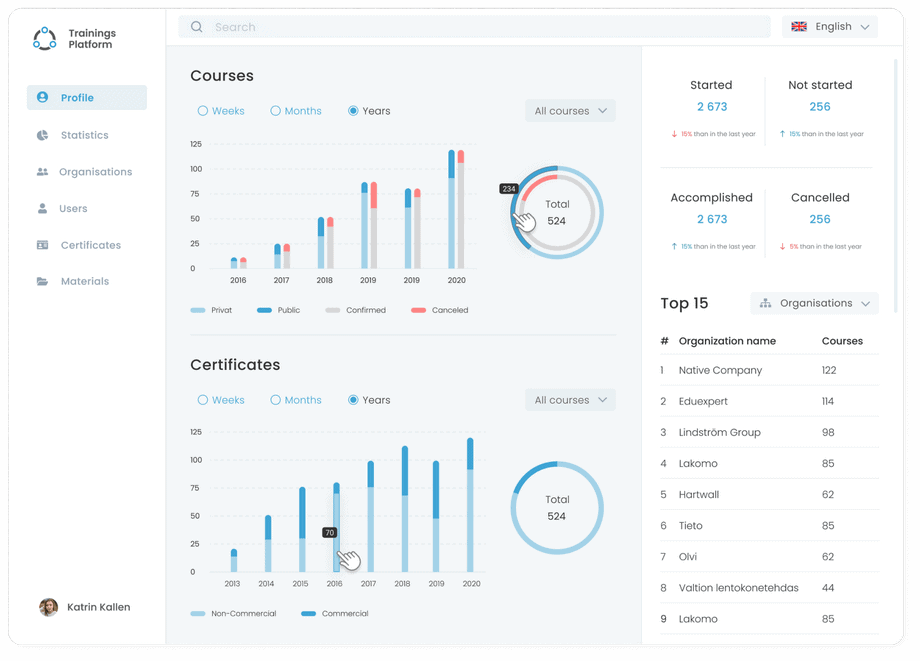Almost any business owner strives for their company’s digital transformation, and 73% are already on the way to their goal. But for many organizations, digitalization remains only a theory. Companies often overlook the training of new employees and the ongoing professional support of existing ones. Let’s look at how the development of eLearning applications helps businesses get engaged and confident team members and becomes a critical success factor.
How does the transformation of learning and training happen?
Digital transformation is the process of introducing innovative digital technologies into all business areas. It involves fundamental changes in technology, culture, operations, and the principles of creating new products or services.
Many people think that digital transformation is limited to the introduction of new technologies into the workflow of a company. But using blockchain, artificial intelligence, or robots alone does not make an organization digital.
It makes no sense to build a business on breakthrough solutions if the leader of a company does not pay equal attention to developing the employees’ skills. After all, machines cannot yet completely replace humans. To “digitize” the workflow, you should invest in developing your employees’ potential. They are the ones who interact with equipment and customers every day. Therefore, an organization’s transition to modern technologies goes hand in hand with the digital transformation of learning.

Source: andersenlab.com
Employee training is an integral part of business development.
There are at least three reasons why the digitalization of training is of crucial importance for companies:
Factor 1. Globalization in business
The 21st century is witnessing rapid changes in the way organizations work. Doing business is becoming increasingly global and intercontinental, and employees can work and learn remotely from anywhere in the world. In this regard, approaches to the development of new skills by team members are changing. The transformation in the way work is done has made many traditional teaching methods obsolete and ineffective. The inability to properly train employees can be a serious disadvantage for companies.
Factor 2. Reformation of the global labor force
Another equally important issue is the massive change in the workforce. The Baby Boomer generation (born between 1946 and 1964) will leave their jobs soon. Their followers – Generation X (the 1960s – 1980s) – will do this in 10-20 years. Millennials (the 1980s – 1990s) and Generation Z (since the 2000s) will soon make up the bulk of the global workforce. That is, there will be a massive outflow of experienced specialists who will take the accumulated corporate knowledge and experience with them.
But that’s not all. The new generation is very careful in choosing a place of work. The youth is primarily interested in motivation and self-development. According to David Wilson, a renowned European HR analyst at Fosway Group, learning is the number one reason people want to join or leave an organization. High staff turnover, in turn, slows down the development of a company and destabilizes its position in the market. As a result, organizations risk losing a significant amount of hidden implicit corporate knowledge.
Factor 3. Impact of automation and artificial intelligence
McKinsey predicts that by 2030 the share of technological skills in the workflow will increase by 52-60%.
These include advanced IT skills, programming, and digital skills. This transformation must be accompanied by appropriate staff training strategies. And this means that organizations should care more about the digital transformation of learning.

Source: andersenlab.com
Digital technology in education: facts and risks
A study by Deloitte confirms the need for learning in the corporate world. Companies with strong learning systems are more ready to innovate and are more likely to get to market faster. These organizations are also 58% faster in anticipating demand and can increase employee productivity by 37%.
Employees at all levels expect dynamic, self-directed, and continuous learning opportunities from their employers. Therefore, companies should be highly interested in how to increase the effectiveness of the development of their teams.
Organizations like IBM are fully aware of the importance of corporate learning and the risk of loss of knowledge due to employees leaving or retiring. The company uses artificial intelligence to predict impending changes with up to 95% accuracy.
According to the training service Logicearth, companies that promote the development of employee mindset are three times more profitable than their competitors. In addition, such organizations are four times more likely to retain employees than firms that do not digitally transform learning.
Today, professionals are interested in a more flexible, personalized, and context-sensitive learning model. Employees feel the need to update their skills regularly. Only in this way will they be able to work effectively in the digital environment. However, PwC found that only 40% of the company’s employees are allowed to upgrade their skills. Based on this, it becomes clear why businesses should count on the digital transformation of learning.
But there are certain obstacles to the digitalization of employee training. It is not enough for organizations to retain a small proportion of experienced specialists to achieve a competitive advantage. Given the volatility of the market and staff turnover, it is a smart decision for enterprises to develop and maintain their own technology-based continuous learning systems.
As Valamis board member Janne Hietala notes, corporate learning and development do little to create an effective learning process and do not test its real value. In most cases, gaining knowledge is not personalized or tailored to individual skills. eLearning applications will improve education by making it more strategic, operational, and personalized.
To solve the problems of continuous learning, companies must use new tools and technologies. Developing eLearning applications is a great business solution that will make the educational process more fun. It will help personalize training for each employee and conduct training without leaving the workplace.

Source: andersenlab.com
eLearning application development
The eLearning industry is projected to grow by $243 billion by the end of 2022. This is 900% more than in 2000. However, the Washington-based company Gallup believes that eLearning applications make concepts easier to understand than the traditional way of learning.
In 2022, the following trends in eLearning application development are especially important:
- building learning management systems (LMS);
- the growing popularity of learning portals;
- development of multifunctional mobile applications and training test software;
- use of AR, VR, and AI;
- gamification of online education.
At the same time, it is possible to create custom eLearning solutions for absolutely any business following its characteristics and goals.
For example, Andersen developed a training platform for occupational health and safety consulting firm. The application is a product with a web client for administrators and trainers and a mobile version for trainees. The first ones can create an event (lecture, course, conference), add new users and upload educational materials according to the OneDrive principle. Students receive certificates with a unique number and a QR code for participating in events. At the same time, users see information about upcoming events based on the data specified in their profiles.

Source: andersenlab.com
The platform described above and its analogs are a powerful tool for a company to interact with its customers and promote services. Such programs have the following advantages:
- Active on-the-job training
Previous approaches to training employees distracted them from daily tasks. People used to believe that a specialist would master a new skill in isolation from the work process and only then be able to integrate it into their activities. In contrast, the custom solutions described above allow employees to master the tools and platforms they use every day through active learning.
- Choosing your preferred learning style
Thanks to digital technology, the educational process can be customized for each employee. For example, one can choose the most appropriate training format (video, audio training, or text documents) or set a comfortable pace for mastering the material.
- Professional development
Efficient training of team members goes beyond completing tasks. It is important to involve employees in the corporate culture so that they are interested in making their company successful. To do this, professionals must try new workflows and test innovative methods. For companies, it is important to provide continuous staff training to ensure that people have the necessary skills and abilities to move the business forward.
In the modern world, digital technologies and education are inseparable from each other. After all, experienced employees are vitally important for the successful digital transformation of growing companies. Personalized training built into the workflow increases the productivity of team members and increases their chances of success. All companies should encourage the development of eLearning applications and create a set of flexible resources that open up a wide range of learning opportunities.

